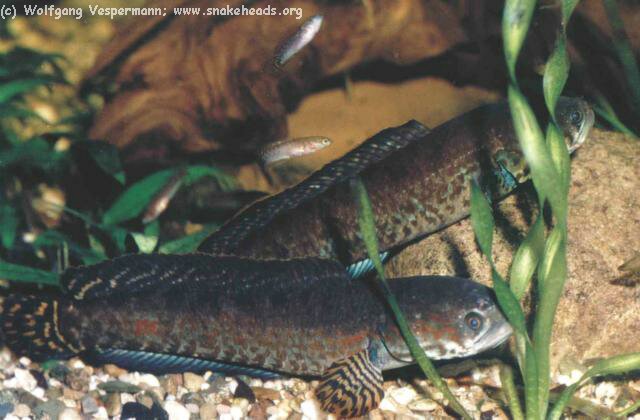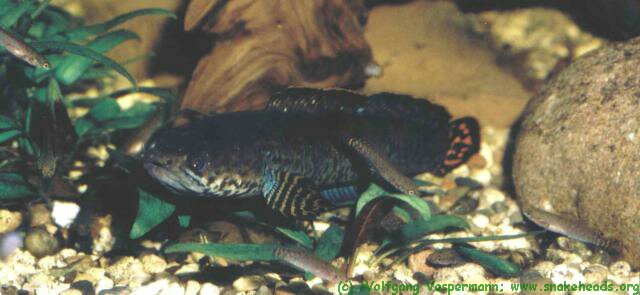
The rainbow snakehead was discovered in 1987 in the upper Dibru River by Heiko Bleher . Jörg Vierke had described them in 1991 1 , and named Channa bleheri after their finder. Vierke also published impressive pictures of a succesful breeding of this small (16 cm) bubble nest building Channa species. Other reports of successful breeding , however, remained rare.
In November 1997, we received six juvenile import samples which were in pretty bad condition. Live food like red midge larva were excreted undigested. A two-day treatment with Nifurpirinol freed the fish from acute bacterial infection. Earthworms and pond fodder mixed with vitamins helped the fish achieve a stable conditions. One of them died though. Frozen food (molluscs, crabs, calamare) were added to the menu. The fish never accepted any commercial fish food (like flakes).
Of the five remaining fish, two couples merged. The leftover one was male. The sex could only be acertained from his behaviour, size was not a differentiating factor for determining sex. The larger of the first couple was male, that of the other female. In autumn 1998 the female ones had developed noticable signs for spawn. But there were neither signs for pairing nor a spawning. The harmony within the couples was interupted by wild fights resulting in destroyed fins. The fights lasted several weeks.
One couple was placed in soft water (5 dGH), the other in hard water (20 dGH). The water hardness evidentially played a minor role with respect to the compfrt level of the fish. The temperature was 25 - 27 ° Celcius, during the months of winter it was reduced to 20 ° Celcius. In the spring 1999 we pulled out all the stops to try and get the fish to breed: live food in abundance, lowering the depth of the water, raising the temperature to 30 ° Celcius, changing to rainwater - but all to no avail. The fish looked magnificient. They rumbled and then were peaceful again. In summer 1999 we lost one couple through the worst possible error for Channa-keeping: the tank was left partially open after feeding and the couple managed to escape (but did not get too far). After this heavy blow, all our hopes rested on the remaining couple. We therefore delved into the living conditions of Channa bleheri . Heiko Bleher mentioned that the snakehead's habitat was the upper Dibrugah/Assam. Via Internet we regularly checked the climatic conditions of this area. In the winter months, the night-time temperatures were between 6 - 10 ° Celcius, rising to over 20 ° Celcius during the day. We therefore decided to give the fish a winter rest by lowering the water temperatures to 13 - 15 ° Celcius and reducing lightning by 8 - 10 hours. To this purpose we placed them in a laundry room for approximately three months. The fish hid themselves in a clay pipe, hardly moved about at all and didn't pay much attention to one another. But at least there were no rumbles. Once in a week they were fed with with white midge larva which were eaten up gradually days later.
 | The breeding couple: In front: the male part and behind it the female part. |
End of April 2000, the couple was moved to a 250 liters (50 gal.) tank with medium-hard water ( two parts rainwater and one part tap water with 20 dGH), 25 ° Celcius. and only a lightly filtered. The filter was placed in the lower part of the aquarium in such a way that it wouldn't create much of a surface current. For vegetation we used one amazonas, anubias and small cryptocorynes . The tank was placed in such a way, that there was direct sunlight until early afternoon. The couple was accompanied (for varying lengths of time) by two ancistrus and several Guppies . The couple soon startet to discover their new environment but held back with pairing up. The female still had a very clear sign for spawn, as was before the winter rest. The couple remained harmonious.
Four weeks passed without change. Suddenly the Guppies, which had only beeb listlesly followed until then, were eaten up in two days. The ancistrus was aggressively pushed below a root. The only noticable change in the environment was fabulous high pressure system which resulted in air temperatures of 33 ° Celcius and a water temperature of 29 ° Celcius. Unfortunately we missed the spawning happened in the early morning hours. We only could observe both partners collecting the very small eggs (several hundreds), swimming at the surface. The male formed a floss of spawn, and brought it to a corner of the tank adorned with air bubbles. Concerning the nest, one couldn't say that it was a bubble nest . After only 30 hours, tadpoles outfitted with a yolk sack slipped out, and were attentively guarded by both partners.
 | The female watching the brood: The female spawns feeder eggs from time to time. This is how the brood get fed. |
By mid July, most members of the brood grew up to the size of 3 cm in length, and they had spread all over the bottom of the tank. Most of them were transferred to other tanks, but some were left with the parents. The parents' care was uninterrupted until we finally separated the young fish from them for good in the middle of August. This led to rumbles: the harmony was gone. By the beginning of September, the brood's size had increased to 6 - 8 cm and resembled their parents very closely. The only difference was their ocellus , the "eye-spot" on the tail fin. Some of them had a double spot, some had none at all.
We hope, that the breeding of this nice snakehead becomes more common and that in this manner the fish may become more widely distributed.
1 Vierke, J.: Channa bleheri sp. n., ein farbenfroher neuer Schlangenkopffisch aus Assam . Das Aquarium, 1991, vol. 25, no. 259: pp. 20 - 24. Vierke, J.: Der Regenbogen-Channa - Haltung und Zucht von Channa bleheri . Das Aquarium, 1991, vol. 25, no. 266: pp. 15 - 19. Back
2 With respect to Channa, this theory was formulated first time by G. Ettrich when he discovered the breeding behavior of C. orientalis and C. gachua . The publishers have heard this from other channa breeders too. In one case, it was mentioned for C. bleheri. In the same magazine, further articles about feeder eggs were published (in German). We try to get the permission for publishing too. For those who are able to read German: pp. 4 - 13. Note of the publishers. Back
3 Vierke, J.: Der Regenbogen-Channa - Haltung und Zucht von Channa bleheri . Das Aquarium, 1991, vol. 25, no. 266: pp. 15 - 19. Back
Bleher, H.: Aquaristische Kostbarkeiten aus dem unbekannten Assam . Aquarium heute, 1989, no. 2/89: pp. 48 - 51.
Vierke, J. (1993): Räuberbande im Aquarium - Schlangenkopffische und andere Räuber . 72 p.; Franckh-Kosmos-Verlag; Stuttgart. This book is out of print. We still do have some books for sale!!! Mail us for ordering
A slightly different German version of this text was published in: Aquaristik Fachmagazin, No. 162, vol. 33(6) - Die Nachzucht des Regenbogenschlangenkopffisches, Channa bleheri . The authors have granted snakeheads.org the right to publish it on the org's site. The translation has been done by snakeheads.org. Thank you Nadine Anderson for proof reading. The photos are taken by Wolfgang Vespermann. The copyright of text and photos is still with the authors/photographer in full amount. The authors can be reached through the email address given above. Thank you Henning and Wolfgangs!
| © 2001 - 2003 snakeheads.org | HOME of this page |